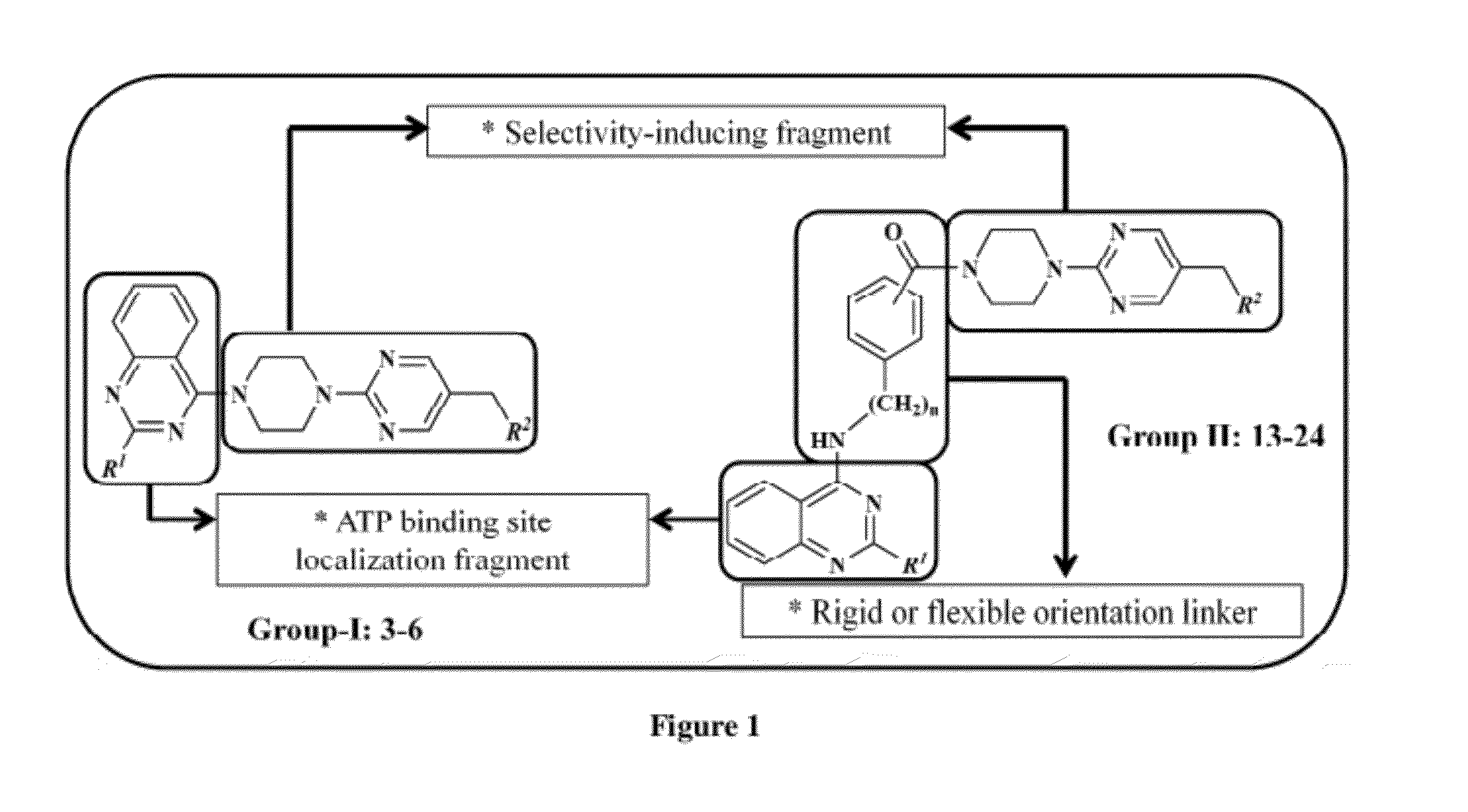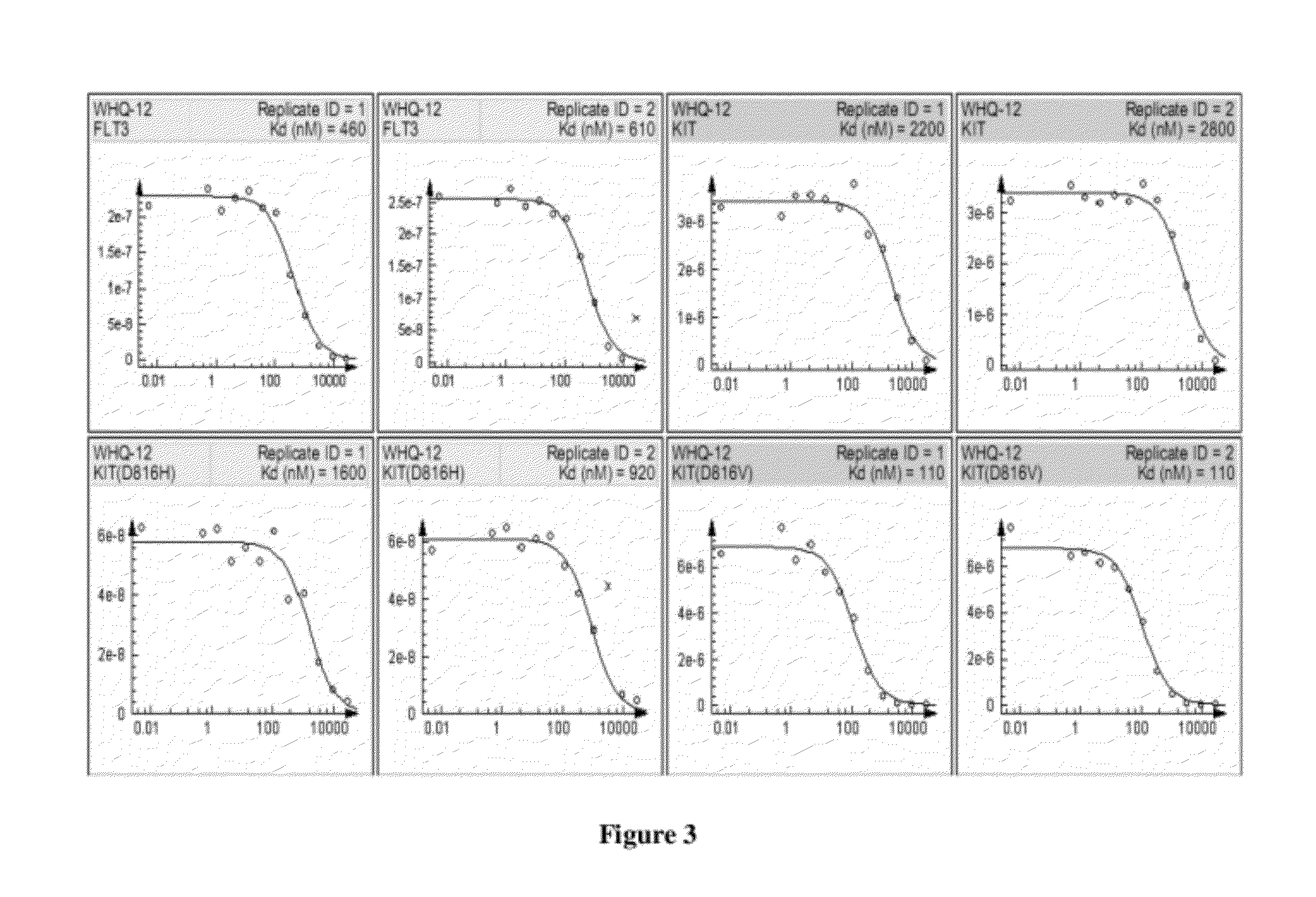Piperazinylpyrimidine analogues as protein kinase inhibitors
a technology of pyrimidine and analogues, which is applied in the field of piperazinylpyrimidine analogs, can solve the problems of troublesome side effects, constant drawbacks of non-selectivity, and difficult design of selective kinase inhibitors
- Summary
- Abstract
- Description
- Claims
- Application Information
AI Technical Summary
Problems solved by technology
Method used
Image
Examples
example 1
Preparation of 5-ethyl-2-(piperazin-1-yl)pyrimidine (1)
[0171]a) A mixture of tert-butyl piperazine-1-carboxylate (6.5 gm, 35.2 mmol), 2-chloro-4-ethylpyrimidine (5 gm, 35.2 mmol), triethylamine (3.55 gm, 35.2 mmol), and absolute ethanol (60 ml) were refluxed for 12 h and then cooled. Ice water was added and the resulting precipitate was filtered, washed with cold water, and finally dried to afford the desired crude intermediate, tert-butyl 4-(5-ethylpyrimidin-2-yl)piperazine-1-carboxylate, as white flakes (9.24 gm, 90% yield); mp: 67-68° C. 1H-NMR (DMSO-d6): δ 1.19 (t, J=7.56 Hz, 3H), 1.46 (s, 9H), 2.47 (q, J=7.56 Hz, 2H), 3.49 (t, J=4.8 Hz, 4H), 3.76 (t, J=4.8 Hz, 4H), 8.19 (s, 2H). 13C-NMR (DMSO-d6): δ 15.59, 22.66, 28.4, 43.76, 43.77, 79.8, 124.95, 154.84, 157.08, 160.05. MS: calcd 292.19 for C15H24N4O2 [M]+; found, 293.19 [M+1]+. b) HCl / MeOH mixture was prepared by adding 10 ml acetyl chloride dropwise to 100 ml methanol at 0° C. The resulting mixture was warmed to room temperat...
example 2
Preparation of 5-benzyl-2-(piperazin-1-yl)pyrimidine (2)
[0172]a) A mixture of K2CO3 (6 gm, 43.5 mmol, 3 equiv) and Pd(PPh3)4 (1 gm, 0.86 mmol) were stirred at room temperature in 20 mL THF / water (1:1) for 30 minutes. Tert-butyl 4-(5-bromopyrimidin-2-yl)piperazine-1-carboxylate (5 gm, 14.5 mmol, 1 equiv) was then added with B-benzyl-9-BBN (2 equiv, 49 ml of a 0.5 M solution in THF). The resulting mixture was heated with stirring under argon atmosphere in an oil bath adjusted at 100-110° C. until the reaction had reached completion, as monitored by TLC. The reaction mixture was extracted with CHCl3 (3×200 mL). The combined organic layers were then dried with anhydrous Na2SO4. Chloroform was evaporated under reduced pressure and the residue was purified using flash column chromatography (initially with 4:1 hexane / ethyl acetate and finally with 1:1 hexane / ethyl acetate). Tert-butyl 4-(5-benzylpyrimidin-2-yl)piperazine-1-carboxylate was obtained as a yellow solid (3.8 gm, 74% yield); mp:...
example 3
Preparation of 4-(4-(5-ethylpyrimidin-2-yl)piperazin-1-yl)quinazoline (3)
[0173]A mixture of 1 (72 mg, 0.377 mmol), 4-chloroquinzoline (61 mg, 0.377 mmol), and triethylamine (38 mg, 0.377 mmol) in isopropanol (5 ml) was refluxed at 80° C. for 1.5 hr. The solid separated out of the reaction was filtered, washed with hot solvent and dried to afford compound 3 which was obtained as a yellow solid (61 mg, 50% yield); mp: >250° C. The purity of 3 was confirmed using HPLC (97.27%, Rt=9.987). 1H-NMR (DMSO-d6): δ 1.13 (t, J=7.56 Hz, 3H), 2.45 (q, J=7.56 Hz, 2H), 3.95 (t, J=5.28 Hz, 4H), 4.16 (t, J=5.28 Hz, 4H), 7.68 (ddd, J=1.38 Hz, J=6.84 Hz, J=8.4 Hz, 1H), 7.96 (m, 2H), 8.22 (d, J=8.4 Hz, 1H), 8.31 (s, 2H), 8.82 (s, 1H). 13C-NMR (DMSO-d6): δ 15.63, 21.91, 42.85, 48.78, 113.28, 121.66, 125.04, 126.69, 126.88, 134.78, 143.5, 149.89, 157.19, 159.95, 162.51. MS: calcd 320.17 for C18H20N6 [M]+; found, 320.39 [M]+.
PUM
| Property | Measurement | Unit |
|---|---|---|
| Volume | aaaaa | aaaaa |
| Volume | aaaaa | aaaaa |
| Volume | aaaaa | aaaaa |
Abstract
Description
Claims
Application Information
 Login to View More
Login to View More - R&D
- Intellectual Property
- Life Sciences
- Materials
- Tech Scout
- Unparalleled Data Quality
- Higher Quality Content
- 60% Fewer Hallucinations
Browse by: Latest US Patents, China's latest patents, Technical Efficacy Thesaurus, Application Domain, Technology Topic, Popular Technical Reports.
© 2025 PatSnap. All rights reserved.Legal|Privacy policy|Modern Slavery Act Transparency Statement|Sitemap|About US| Contact US: help@patsnap.com



